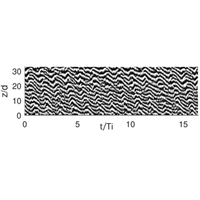当前位置:
X-MOL 学术
›
Phys. Rev. Fluids
›
论文详情
Our official English website, www.x-mol.net, welcomes your feedback! (Note: you will need to create a separate account there.)
Defect-mediated turbulence in bubbly Taylor-Couette flow
Physical Review Fluids ( IF 2.7 ) Pub Date : 2020-03-09 , DOI: 10.1103/physrevfluids.5.034302 Bruno Van Ruymbeke , Noureddine Latrache , Céline Gabillet , Catherine Colin
Physical Review Fluids ( IF 2.7 ) Pub Date : 2020-03-09 , DOI: 10.1103/physrevfluids.5.034302 Bruno Van Ruymbeke , Noureddine Latrache , Céline Gabillet , Catherine Colin

|
We investigate experimentally the defect-mediated turbulence (DMT) which is induced by bubbles injection in a Taylor-Couette flow when the inner cylinder is rotating while the outer cylinder is fixed. Bubbles of 1.2 mm in diameter are injected at the bottom of a Taylor-Couette device of radii ratio equal to 0.91. The tangential Reynolds number range is and the air injection rate varies up to 800 ml/min. For these conditions of the experiments, bubbles are trapped in the gap by the Taylor vortices and arranged as patterns (toroidal, wavy toroidal, spirals, and wavy spirals). Visualizations of the bubble patterns were carried out. When decreasing the Reynolds number or increasing the air injection rate, spiral and toroidal patterns can coexist in a composite flow. Defects occur in the bubble's patterns (merging or splitting of the Taylor vortex pairs). By analyzing the space-time diagram of bubbles patterns and their complex demodulation, we highlight different regimes and transitions in the DMT of the bubbly Taylor-Couette flow. The control parameter of the transitions is the air volumetric fraction, which evolves as the ratio between the axial injection Reynolds number and the tangential Reynolds number. By increasing the air volumetric fraction, the defects in the DMT flows are classified as three flow regimes: (i) structured composite flow where the defects are periodic in space and time, (ii) intermittency defects chaos where the defects zones alternate randomly with the patterns in time and space, and (iii) developed defects chaos with a large defects density. The statistical properties of these three regimes of the DMT are analyzed in the framework of the complex Ginzburg-Landau equation.
中文翻译:

气泡状泰勒-库埃特流中的缺陷介导的湍流
我们实验研究缺陷介导的湍流(DMT),该缺陷介导的湍流由内圆柱体旋转而外圆柱体固定的Taylor-Couette流中的气泡注入引起。将直径为1.2 mm的气泡注入半径比等于0.91的Taylor-Couette装置的底部。切向雷诺数范围是空气注入速度最高可达800 ml / min。对于这些实验条件,气泡被泰勒涡旋捕获在间隙中,并以图案(环形,波浪形,螺旋形和波浪形螺旋形)排列。气泡图的可视化。当降低雷诺数或增加空气注入速率时,螺旋和环形模式可以共存于复合流中。气泡的图案中会发生缺陷(泰勒涡流对的合并或分裂)。通过分析气泡模式的时空图及其复杂的解调,我们突出了气泡状Taylor-Couette流的DMT中的不同状态和过渡。过渡的控制参数是空气体积分数,它随着轴向注入雷诺数和切向雷诺数之比的变化而变化。通过增加空气体积分数,将DMT流动中的缺陷分为三种流动形式:(i)结构化复合流,其中缺陷在时间和空间上是周期性的;(ii)间歇性缺陷混沌,其中缺陷区域与缺陷之间随机交替。 (iii)形成具有大缺陷密度的缺陷混沌。在复数Ginzburg-Landau方程的框架内分析了DMT的这三种状态的统计特性。(ii)断续的缺陷混沌,其中缺陷区域随时间和空间的模式随机变化,并且(iii)形成具有大缺陷密度的缺陷混沌。在复数Ginzburg-Landau方程的框架内分析了DMT的这三种状态的统计特性。(ii)断续的缺陷混沌,其中缺陷区域随时间和空间的模式随机变化,并且(iii)形成具有大缺陷密度的缺陷混沌。在复数Ginzburg-Landau方程的框架内分析了DMT的这三种状态的统计特性。
更新日期:2020-03-09
中文翻译:

气泡状泰勒-库埃特流中的缺陷介导的湍流
我们实验研究缺陷介导的湍流(DMT),该缺陷介导的湍流由内圆柱体旋转而外圆柱体固定的Taylor-Couette流中的气泡注入引起。将直径为1.2 mm的气泡注入半径比等于0.91的Taylor-Couette装置的底部。切向雷诺数范围是空气注入速度最高可达800 ml / min。对于这些实验条件,气泡被泰勒涡旋捕获在间隙中,并以图案(环形,波浪形,螺旋形和波浪形螺旋形)排列。气泡图的可视化。当降低雷诺数或增加空气注入速率时,螺旋和环形模式可以共存于复合流中。气泡的图案中会发生缺陷(泰勒涡流对的合并或分裂)。通过分析气泡模式的时空图及其复杂的解调,我们突出了气泡状Taylor-Couette流的DMT中的不同状态和过渡。过渡的控制参数是空气体积分数,它随着轴向注入雷诺数和切向雷诺数之比的变化而变化。通过增加空气体积分数,将DMT流动中的缺陷分为三种流动形式:(i)结构化复合流,其中缺陷在时间和空间上是周期性的;(ii)间歇性缺陷混沌,其中缺陷区域与缺陷之间随机交替。 (iii)形成具有大缺陷密度的缺陷混沌。在复数Ginzburg-Landau方程的框架内分析了DMT的这三种状态的统计特性。(ii)断续的缺陷混沌,其中缺陷区域随时间和空间的模式随机变化,并且(iii)形成具有大缺陷密度的缺陷混沌。在复数Ginzburg-Landau方程的框架内分析了DMT的这三种状态的统计特性。(ii)断续的缺陷混沌,其中缺陷区域随时间和空间的模式随机变化,并且(iii)形成具有大缺陷密度的缺陷混沌。在复数Ginzburg-Landau方程的框架内分析了DMT的这三种状态的统计特性。



























 京公网安备 11010802027423号
京公网安备 11010802027423号